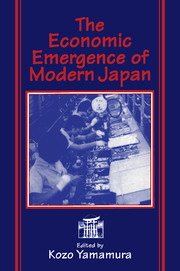Book contents
- Frontmatter
- Contents
- Preface
- 1 Economic change in the nineteenth century
- 2 Industrialization and technological change, 1885–1920
- 3 Depression, recovery, and war, 1920–1945
- 4 The postwar Japanese economy, 1945–1973
- 5 Capital formation in Japan
- 6 Factory labour and the industrial revolution in Japan
- 7 Entrepreneurship, ownership, and management in Japan
- Bibliography
- Index
3 - Depression, recovery, and war, 1920–1945
Published online by Cambridge University Press: 04 August 2010
- Frontmatter
- Contents
- Preface
- 1 Economic change in the nineteenth century
- 2 Industrialization and technological change, 1885–1920
- 3 Depression, recovery, and war, 1920–1945
- 4 The postwar Japanese economy, 1945–1973
- 5 Capital formation in Japan
- 6 Factory labour and the industrial revolution in Japan
- 7 Entrepreneurship, ownership, and management in Japan
- Bibliography
- Index
Summary
INTRODUCTION
The Japanese economy experienced great changes as a result of World War I. With the disappearance of European and American products from Asian and African trade, these extensive markets suddenly became wide open to Japanese products. Export volume and prices shot up, and Japan's industries reveled in an unprecedented boom. A spate of new firms appeared in rapid succession; stock prices soared; and the whole country rang with the sound of hammers at work on new-factory construction. Products like steel, machinery, and chemicals, for which Japan had been dependent on imports, began to be produced domestically. From its status as a debtor nation to the tune of ¥1.1 billion on the eve of the war in 1913, Japan had, by the end of 1920, transformed itself into a creditor nation with a surplus exceeding ¥2 billion. Despite social unrest such as the 1918 rice riots and the intensification of the labor and peasant movements that accompanied the galloping inflation produced by the war boom, the Japanese economy expanded as a result of the war.
When the war ended, however, so did the boom. Because of the renewed export competition and the resumption of imports that had long been suspended while Europe was at war, the international payments balance reverted to a deficit, and holdings of gold and foreign exchange began to diminish. This chapter will trace the path of the Japanese economy from the 1920s to the end of the Pacific War.
- Type
- Chapter
- Information
- The Economic Emergence of Modern Japan , pp. 116 - 158Publisher: Cambridge University PressPrint publication year: 1997
- 4
- Cited by



